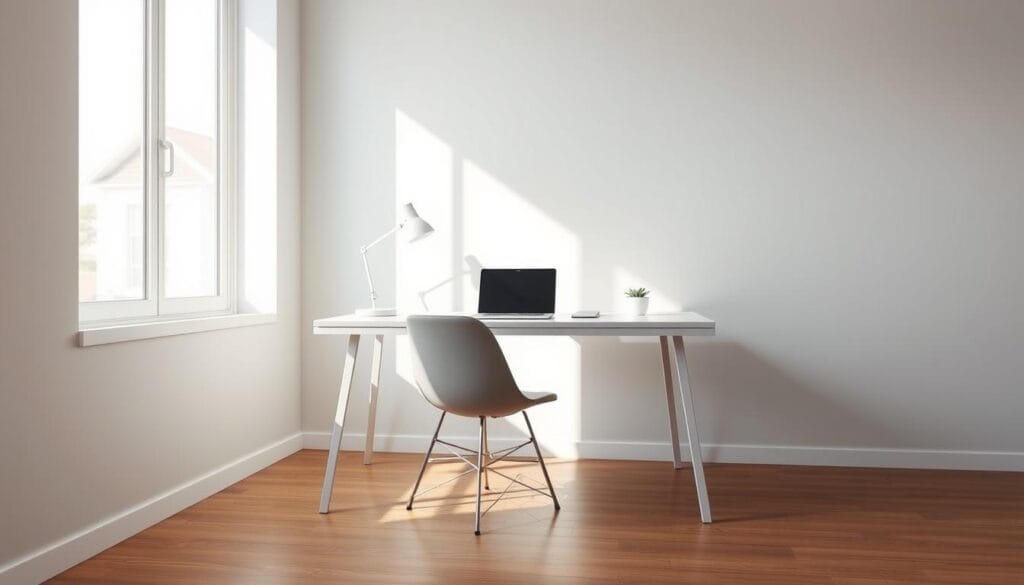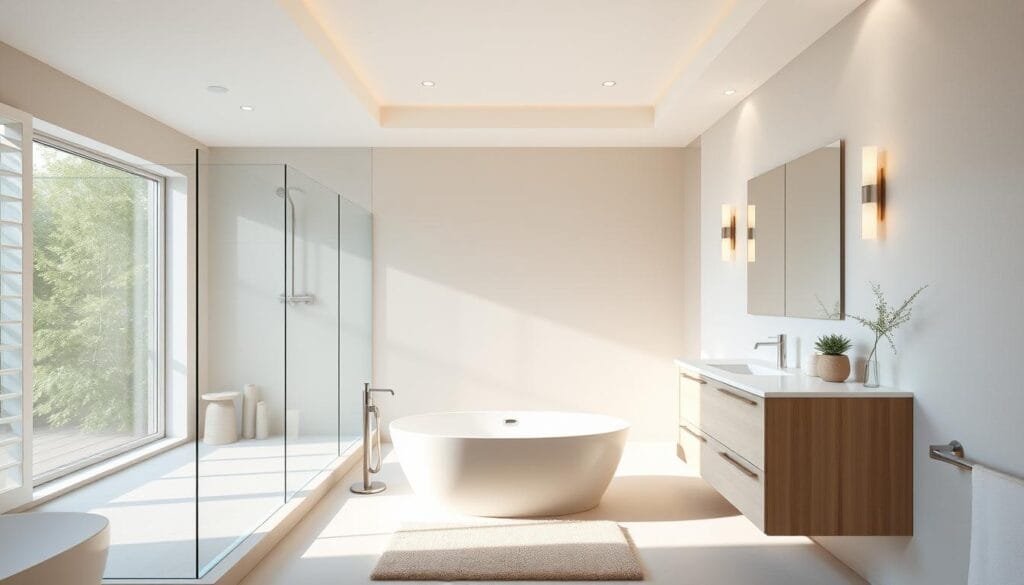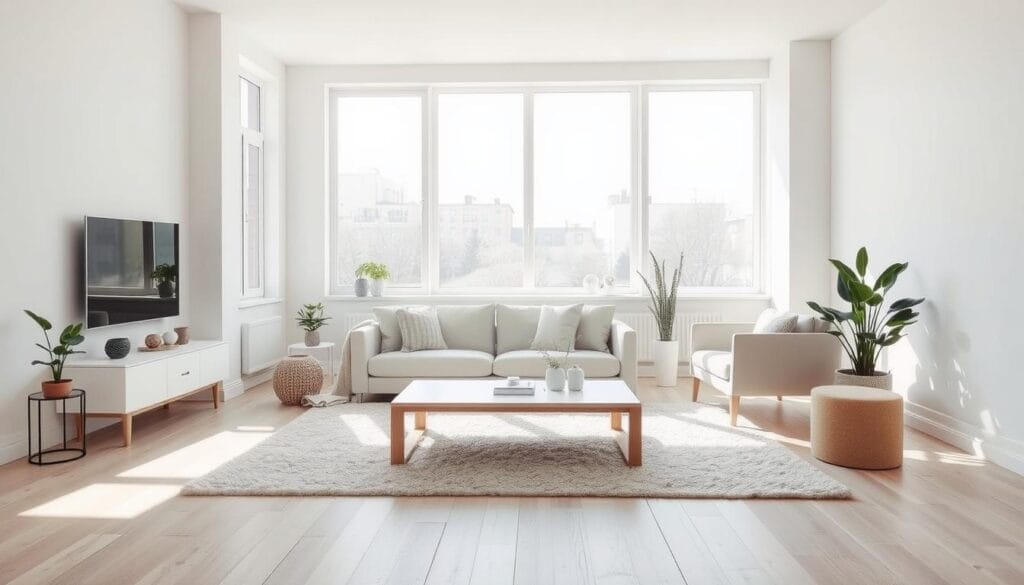Imagine walking into your home office to find everything in its right place, without any clutter. After a messy week full of online meetings and lost papers, I knew I needed a change. So, with coffee and a strong will, I started my journey towards a minimalist office.
Minimalism is more than just a design trend, it’s a way of introducing calm and simplicity into our lives. Businesses with clean desks see better focus and productivity. That’s why many now choose minimalist designs to make their offices look better and work more efficiently.
Studies show that a tidy workspace can cut stress by 30% and boost productivity by 20%. This idea struck a chord with me. It made me wonder if a simple, modern office could help balance work and life better.
With more people working from home due to the pandemic, the way we set up our offices is changing. A study by the Harvard Business Review found that open offices can lower how much we interact by up to 70%. So, having a neat home office is more crucial than ever.
Setting up a minimalist office means being intentional about your space. Whether it’s a corner in your living room or a whole room, are you ready for a change? Let’s look at how minimalist design can make your office a peaceful and productive place.
Looking for ways to balance your home office? Check out these inspiring home office ideas. You’ll discover tips to keep your space simple yet productive.
Understanding Minimalist Office Design Principles
In our journey to creating a harmonious workspace, understanding minimalist office design principles is crucial. These principles not only make your surroundings simple but also boost productivity and mental clarity. Let’s explore the main ideas of minimalism and its important features.
What is Minimalism?
Minimalism started in the mid-20th century and is seen in art and lifestyle choices. It focuses on simplicity, function, and removing clutter. We aim to create spaces with only necessary items, leading to a minimalist office that cuts down distractions and increases work efficiency.
Key Characteristics of Minimalist Design
Minimalist design is known for its clean lines, simple color schemes, and smart use of space. When making a minimalist office, we choose soft colors like white, grey, and beige to make a peaceful setting. We also use furniture that has more than one use to save space and keep things organized in a minimalist way.
Minimalist design also loves natural light. This not only lowers energy use but also improves mood and focus by 15%. Adding plants can make the air cleaner, increasing air quality by up to 20%. Using these design rules can make stress drop by 30% for people working in the office.
Benefits of a Minimalist Office Environment
A minimalist office is not just nice to look at; it boosts our work and mental state. A simple, clean office can make us more focused, efficient, and less stressed.
Enhanced Focus and Productivity
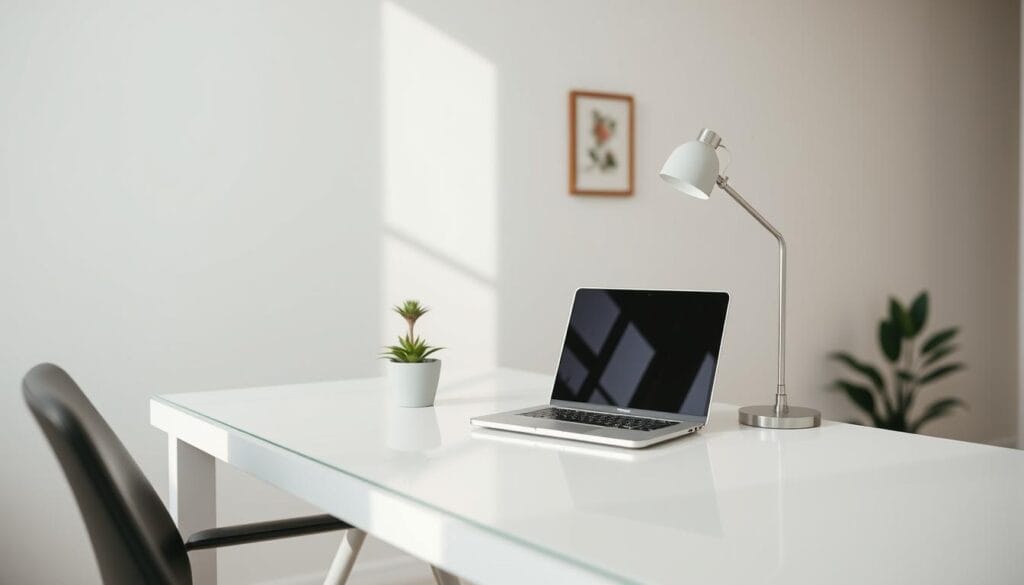
Simple office designs can greatly improve our focus and work output. Studies show that messy desks can lower concentration by up to 30%. Meanwhile, a tidy office boosts workflow and makes us 20% happier with our jobs.
Also, minimalist offices save money on supplies and furniture. They use space wisely, which can boost productivity by 15%.
Stress Reduction and Mental Clarity
A tidy office helps clear our minds, lowering stress and anxiety by 20%. Clean spaces not only make us work better but also create a peaceful environment. Spending 20 minutes to tidy up daily boosts organization and work quality.
Additionally, simple offices are flexible. They can change to fit the team’s and the business’s needs. Clear layouts improve communication and teamwork during the day.
In conclusion, a minimalist office makes a big difference in our work life. It sharpens our focus, increases productivity, and brings down stress levels. Choosing minimalist designs can lead to a healthier and more productive work area.
Essential Elements of Minimalist Office Design
Creating a minimalist office means choosing elements that make the space simple, functional, and calm. We will look at choosing colors, materials, and furniture to make this happen.
Color Palette and Materials
A minimalist office usually uses neutral colors like white, gray, and beige. These colors help create a peaceful space, cutting down on distractions. Sometimes, adding a splash of color can make the office more lively. Letting in plenty of natural light makes the office feel more open and airy.

The focus is on simple, high-quality materials. Using wood, stone, and metal adds durability and a classic look. These materials bring warmth and texture to the office. Glass helps make the space feel more open by reflecting light.
Furniture Selection
Choosing the right furniture is key to a minimalist office. Look for furniture that is simple, functional, and has clean lines. For example, a desk with built-in storage helps keep things tidy by hiding clutter.
Modular furniture is great because it can change as your needs do. This keeps the office useful over time. Comfortable, simple chairs are important for staying comfortable all day.
With these key elements, your minimalist office will not only look good. It will also help with productivity, happiness, and job satisfaction.
Creating a Minimalist Workspace at Home
Transforming your home office into a minimalist space can boost your work and lower stress. It’s about picking a great spot and keeping things tidy. Let’s explore how to make this happen for you.
Choosing the Right Location
Where you set up your office matters a lot. A place with lots of natural light is ideal. Natural light has been found to make people up to 20% more productive. So, placing your desk by a window is a smart choice. It offers sunlight and a nice view to enjoy during breaks.
It’s also key to find a quiet area where noise won’t distract you. Whether it’s a corner in your living room, a big closet, or a section of your bedroom, being away from noise is crucial. This helps in making a space that encourages focus.
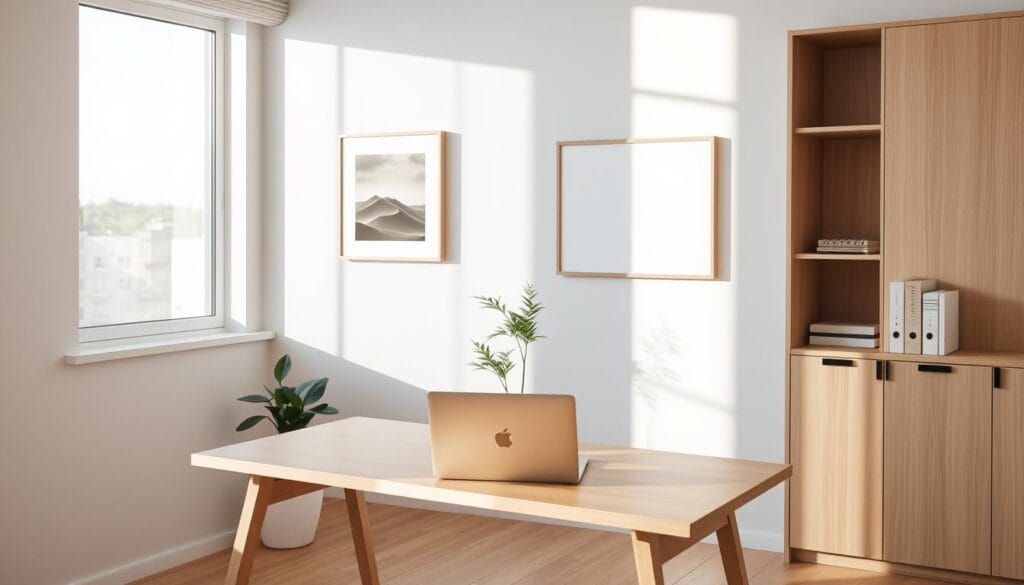
Organizing Your Home Office
Finding the right spot is the first step, and next is organization. Starting with a clutter-free zone is essential. Did you know 65% of people working from home say clutter hampers their productivity? Use the KonMari method to sort things out: keep what you need and declutter the rest. It simplifies keeping your space neat.
Thinking about comfort, ergonomic furniture is key. It can cut discomfort by 25% during long hours of work. Best of all, ergonomic chairs and desks help in improving your work and keeping your body happy. Also, choosing furniture that serves more than one purpose and offers hidden storage can make organization 40% better. This helps in keeping your workspace tidy.
Bringing in plants can make a big difference, too. A whopping 90% of workers love having plants around because they boost mood and clean the air. And remember, organizing digitally is just as important. Around 78% of workers believe digital tools lessen clutter. Using these tools helps in managing your tasks well.
- Choose a quiet spot with natural light.
- Declutter using the KonMari method.
- Invest in ergonomic furniture for comfort.
- Utilize multifunctional and hidden storage solutions.
- Add some plants for mood enhancement and air quality.
- Incorporate digital tools to manage tasks and reduce physical clutter.
Following these tips for a minimalist home office will create a productive and motivating space. A neat and minimalist workspace isn’t just about looks; it’s about making your work and creativity soar.
Tools and Accessories to Support Minimalism
Exploring minimalist office design involves looking at digital decluttering tools and essential office supplies. These help keep your workspace clean and boost productivity. By using these tools, you can enjoy a more organized, efficient, and calm work area.
Digital Tools for Decluttering
Digital decluttering tools are key to minimizing online mess. Using Evernote for notes, Dropbox for saving files online, and Todoist for managing tasks makes your work smoother. These tools cut down the time you spend looking for files and emails by about 10 hours every month.
The Anker PowerPort Cube Power Strip, with three plugs and three USB slots, keeps your desk tidy while providing easy power access. Another neat tool is the GAZEPAD PRO, which is both a mouse pad and a wireless charger. It combines important features into one elegant device.
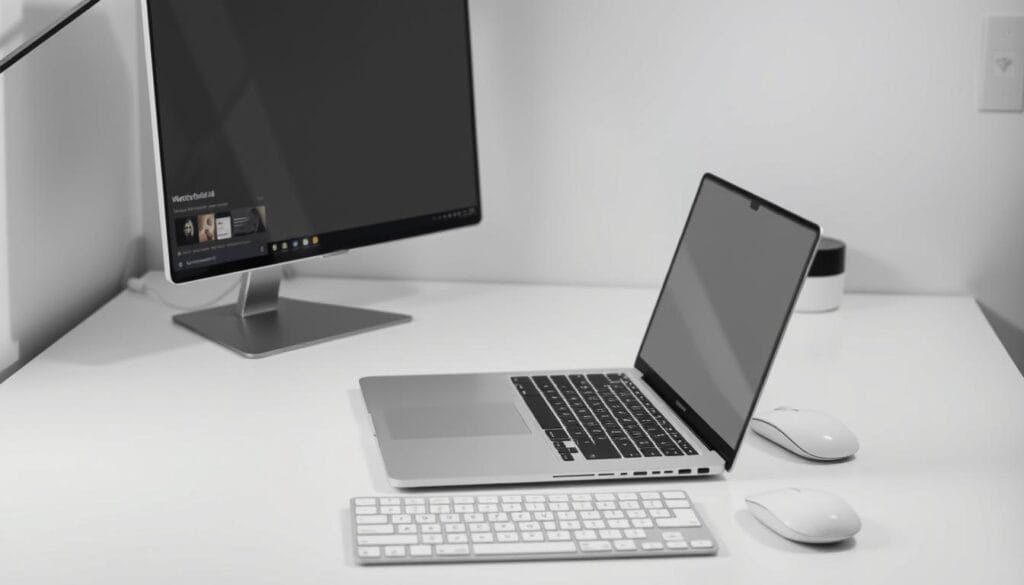
Must-Have Office Supplies
Minimalist office items greatly improve workspace functionality and neatness. The STEALTHO Desk Organizer, with its 12 functions including a charger and pen holder, is perfect for any minimalist office. The Twelve South BookArc möd for MacBook helps manage cables and keeps devices in order.
Ergonomic furniture is vital for a minimalist office. The UPERGO Standing Desk Converter changes a regular desk into a standing one, reducing muscle strain and increasing productivity by 50%. Solutions like the Silk Cable Wrangler Magnetic Cord Organizer cut down on clutter by 70%, making for a cleaner, more focused work area.
Using the right tools and supplies can improve focus and lower stress. Studies show an organized workspace can boost work efficiency by about 30% and reduce stress by up to 40%. By focusing on functionality and simplicity, you can create a space that supports both productivity and well-being.
How to Maintain a Minimalist Office Space
Keeping a minimalist office is more than just setting it up. It’s a process that includes regular cleaning and staying mindful. Let’s explore how to keep this calm environment to boost productivity and wellness.
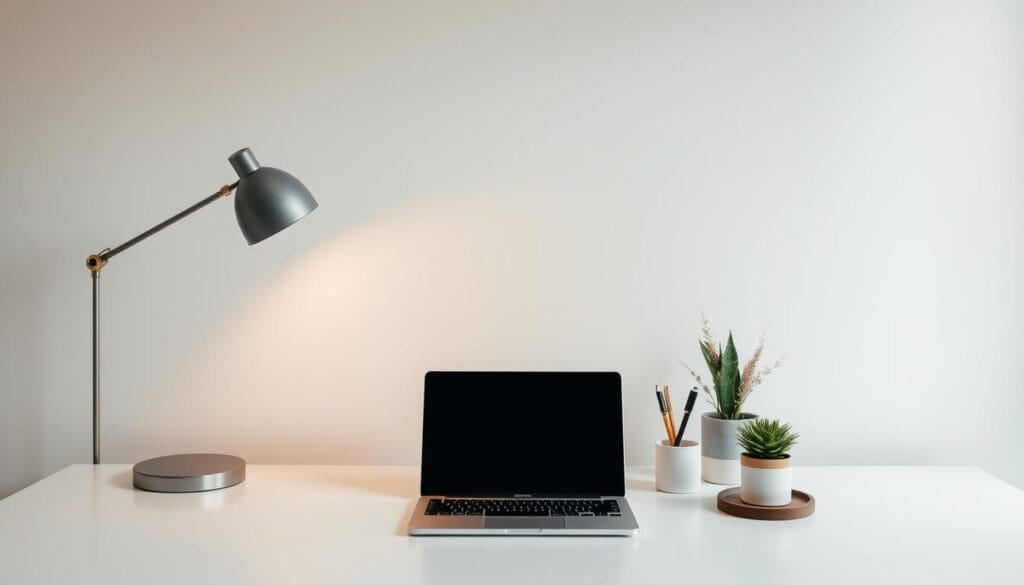
Regular Decluttering Habits
Sustainability in minimalist design needs regular decluttering. Take a few minutes each week to look over your space. Remove items that aren’t needed or don’t make you happy. Studies have found that an organized workspace can increase productivity by up to 25% and lower stress by 30%. A clean environment gives a sense of control and satisfaction, 75% of people agree.
- Keep only essential items on your desk.
- Regularly sort through papers and digitize documents to minimize physical storage needs.
- Discard or store away non-essential items to avoid accumulating unnecessary belongings.
A tidy space is key to minimalist maintenance. It helps with mental clarity and productivity. Half of office workers feel stressed by clutter, affecting their job happiness. So, it’s crucial to keep your space neat.
Mindfulness Practices for Sustainability
Being mindful about our workspace items is vital for a minimalist design. It’s important to form habits that create a peaceful and focused work environment.
- Adopt a ‘one in, one out’ rule for office supplies.
- Engage in short physical activities during work hours to boost focus and energy by 15-25%.
- Use multifunctional furniture to save up to 30% of floor space in smaller offices.
Mindfulness also means keeping work and home life separate, which can better work-life balance by 40%. A minimalist space’s calm feeling matches these practices well. It keeps us centered and focused.
Also, it’s good to review papers like tax records regularly. Choosing to stop junk mail can cut down on clutter. Around 80% of people feel less stressed in a minimalist space than in a cluttered one.
By using regular cleaning habits and mindfulness, we keep our minimalist office looking good and sustainable. Remember, keeping a minimalist office is ongoing. But, it’s worth it for your productivity and well-being.
Real-Life Examples of Minimalist Office Design
Exploring real-life minimalist office designs helps us understand their principles and benefits. Looking at case studies and designers’ work gives us ideas to improve our workspaces. These practical examples show the blend of beauty and function in minimalist design.
Case Study: Tech Company Offices
Tech companies often lead in minimalist office designs. For example, Apple’s headquarters in Cupertino shows how minimalism can boost productivity and innovation. Its open layout helps teamwork, and materials like glass and wood create a calm, focused space. Google’s NYC office uses minimalist design too, with flexible spaces that make the most of small areas. These examples from tech show how minimalist design can better our workplaces.
Inspiration from Interior Designers
Designers like Marie Kondo and Norrgavel inspire with their minimalist office designs. Kondo focuses on decluttering for clearer thinking. Norrgavel blends ‘lagom’ and ‘hygge’ for comfy, balanced offices. They use natural light and soft colors to make spaces welcoming yet undistracting. These designs not only look good but improve work and mental health.
| Key Features | Apple HQ | Google NYC | Marie Kondo | Norrgavel |
|---|---|---|---|---|
| Open Floor Plan | Yes | Yes | No | Yes |
| Use of Natural Materials | Glass, Wood | Wood | Various | Natural Light |
| Space Optimization | Built-in Desks | Cabinetry | Decluttering | Subtle Tones |
| Productivity Impact | High | High | Moderate | High |
Studying these case studies and following top designers’ ideas, you can turn your workspace into a beautiful, efficient place. Minimalist design is more than style—it’s about fostering creativity, focus, and well-being.
Common Mistakes in Minimalist Office Design
Creating a minimalist office seems easy, but some common errors can ruin its simplicity and function. We’ll look at two big mistakes: making the place too complicated and ignoring your own style.
Overcomplicating the Layout
One major mistake is making the office layout too complicated. This mistake can make a space less calming. A study from Harvard found that less visual clutter could make you 32% more productive.
To avoid this, choose essential furniture and decorations that allow easy movement and function. Good space arrangement makes the office calm and makes people happier at work.
Ignoring Personal Style
Ignores personal style is another error. Minimalism doesn’t mean your space has to feel cold or impersonal. Adding your own taste can make your office more welcoming and inspiring.
Personalizing your office can boost morale and help the business succeed. You might add art, plants, or special pieces that show your style.
When you include your personal style, your minimalist office becomes a place you love to be. A great space isn’t just clutter-free. It’s about smart design choices.
Look at places like KAAN Architecten’s HQ or the NeriHu studio in Shanghai. They mix great design with usefulness. Using natural light and comfy furniture can also enhance your office, keeping it productive and relaxing. Adding personal style keeps your office true to minimalism but also true to you.
Future Trends in Minimalist Office Design
Looking ahead to 2025, office design is taking on a minimalist approach with new features for today’s work needs. Offices have changed a lot in 50 years because of new culture and technology. Now, there’s a big focus on making spaces that can change, welcome everyone, and inspire people. These spaces also aim to help employees do their best work and feel good.
Incorporating Smart Technology
Smart technology is now a big part of minimalist offices. Around 80% of today’s offices are adding tech solutions. This includes smart lockers, lights you can control automatically, and systems to manage the temperature. Such tech makes work smoother and keeps the office running without a hitch. By 2024, half of the companies plan to use smart lockers to keep things organized and easy to use. This is because they can be adjusted for each person’s needs, helping everyone work better.
Eco-Friendly Materials and Sustainability
Choosing sustainable designs is about more than just following trends. It shows a real effort to make workspaces that are good for the planet. Companies like Google and Apple are leading this effort. They use natural stuff and design that makes you feel like you’re around nature. These choices can make employees up to 15% happier and more satisfied with their job. Also, 75% of workers feel better about their company when it uses green design. With a focus on materials that are good for the Earth, future offices will not only help people be more productive but also help the planet.
Want to learn more about these exciting changes in office design? For a closer look at what’s coming in minimalist office design, check this cool article from Decorilla. Go to office design trends for 2025. You’ll find great examples and ideas that can help make your office both efficient and green.

